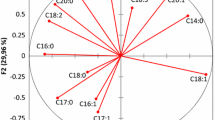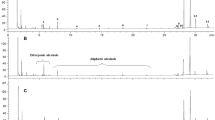Abstract
Because of the importance of cultivar and growing area on the quality and quantity of extracted olive oil, this study examined the effects of two different growing areas (Qom (subdesertic) and Gorgan (Caspian zone) that have important differences in altitude, latitude, and climatic conditions on the physicochemical characteristics of extracted oils from three common cultivars (Beleydi, Mission and Koroneiki) growing in Iran. Independently of the growing area conditions, Beleydi cultivars showed the lowest values of oil content (16.93 ± 1.55 and 43.54 ± 0.18 % in Qom and Gorgan, respectively) the greatest acidity, even higher than the limits specified by the International Olive Council (IOC) regulations (1.04 and 0.46 % in Qom and Gorgan, respectively), and the lowest oxidative stability (9.0 and 6.7 h in Qom and Gorgan, respectively) among the studied cultivars. All cultivars growing in Qom had lower oil contents, but they had higher oleic acid and β-sitosterol content and lower PUFA/SFA ratios in comparison with cultivars grown in Gorgan. Therefore, cultivars grown in Qom had higher oxidative stability. Finally, when principal component analysis (PCA) was applied, the fatty acid and sterol profiles could be used to separate olive samples according to their cultivar and growing area, respectively.


Similar content being viewed by others
References
Krichène D, Allalout A, Salvador MD, Fregapane G, Zarrouk M (2010) Fatty acids, volatiles, sterols and triterpenic alcohols of six monovarietal Tunisian virgin olive oils. Eur J Lipid Sci Technol 112(3):400–409
Wiesman Z (2009) Desert Olive Oil Cultivation: Advanced Biotechnologies, Academic Press, p266, 288, 299, 36, 38
Gómez-González S, Ruiz-Jiménez J, Luque de Castro MD (2011) Oil content and fatty acid profile of spanish cultivars during olive fruit ripening. J Am Oil Chem Soc 88(11):1737–1745
Lukic M, Lukic I, Krapac M, Sladonja B, Pilizota V (2013) Sterols and triterpene diols in olive oil as indicators of variety and degree of ripening. Food Chem 136(1):251–258
Temime SB, Campeol E, Cioni PL, Daoud D, Zarrouk M (2006) Volatile compounds from Chétoui olive oil and variations induced by growing area. Food Chem 99(2):315–325
Hashempour A, Fotouhi Ghazvini R, Bakhshi D, Asadi S (2010) Fatty acids composition and pigments changing of virgin olive oil (Olea europea L.) in five cultivars grown in Iran. Aust J Crop Sci 4(4):258–263
Mailer RJ, Ayton J, Graham K (2010) The Influence of growing region, cultivar and harvest timing on the diversity of Australian olive oil. J Am Oil Chem Soc 87(8):877–884
Manai-Djebali H, Krichène D, Ouni Y, Gallardo L, Sánchez J, Osorio E, Daoud D, Guido F, Zarrouk M (2012) Chemical profiles of five minor olive oil varieties grown in central Tunisia. J Food Compos Anal 27(2):109–119
Bengana M, Bakhouche A, Lozano-Sánchez J, Amir Y, Youyou A, Segura-Carretero A, Fernández-Gutiérrez A (2013) Influence of olive ripeness on chemical properties and phenolic composition of Chemlal extra-virgin olive oil. Food Res Int 54(2):1868–1875
Guerfel M, Ouni Y, Taamalli A, Boujnah D, Stefanoudaki E, Zarrouk M (2009) Effect of location on virgin olive oils of the two main Tunisian olive cultivars. Eur J Lipid Sci Technol 111(9):926–932
Lazzez A, Vichi S, Kammoun NG, Arous MN, Khlif M, Romero A, Cossentini M (2011) A four year study to determine the optimal harvesting period for Tunisian Chemlali olives. Eur J Lipid Sci Technol 113(6):796–807
Aguilera MP, Beltrán G, Ortega D, Fernández A, Jiménez A, Uceda M (2005) Characterisation of virgin olive oil of Italian olive cultivars: ‘Frantoio’ and ‘Leccino’, grown in Andalusia. Food Chem 89(3):387–391
Arslan D, Karabekir Y, Schreiner M (2013) Variations of phenolic compounds, fatty acids and some qualitative characteristics of Sarıulak olive oil as induced by growing area. Food Res Int 54(2):1897–1906
Issaoui M, Flamini G, Brahmi F, Dabbou S, Hassine KB, Taamali A, Chehab H, Ellouz M, Zarrouk M, Hammami M (2010) Effect of the growing area conditions on differentiation between Chemlali and Chétoui olive oils. Food Chem 119(1):220–225
Temime S, Manai H, Methenni K, Baccouri B, Abaza L, Daoud D, Casas J, Bueno E, Zarrouk M (2008) Sterolic composition of Chétoui virgin olive oil: influence of geographical origin. Food Chem 110(2):368–374
Food and Agriculture Organization Islamic Republic of Iran, http://www.fao.org/ag/AGP/AGPC/doc/counprof/Iran/Iran.htm. (accessed March 2014)
Ayerza R, Steven Sibbett G (2001) Thermal adaptability of olive (Olea europaea L.) to the Arid Chaco of Argentina. Agric Ecosyst Environ 84(3):277–285
Moghaddam G, Heyden YV, Rabiei Z, Sadeghi N, Oveisi MR, Jannat B, Araghi V, Hassani S, Behzad M, Hajimahmoodi M (2012) Characterization of different olive pulp and kernel oils. J Food Compos Anal 28(1):54–60
Mirhosseini M (2007) Organic Agriculture in Islamic Rep. of Iran: opportunities and challenges. In: international conference and study meeting on: Organic Agriculture for Promoting Green Productivity and Agribusiness exports code: 07-ag-32-ge-stm-b, New Delhi, India
Kramer R (1998) Chemometric techniques for quantitative analysis. Marcel Dekker, New York
Eui-Cheol Shin, Craft BD, Pegg RB, Phillips RD, Eitenmiller RR (2010) Chemometric approach to fatty acid profiles in Runner-type peanut cultivars by principal component analysis (PCA). Food Chem 119:1262–1270
Chudzinska M, Baralkiewicz D (2011) Application of ICP-MS method of determination of 15 elements in honey with chemometric approach for the verification of their authenticity. Food Chem Toxicol 49:2741–2749
Zielinski AAF, Haminiuk CWI, Alberti A, Nogueira A, Demiate IM, Granato D (2014) A comparative study of the phenolic compounds and the in vitro antioxidant activity of different Brazilian teas using multivariate statistical techniques. Food Res Int 60:246–254
American Oil Chemists’ Society (1998) Official Methods and Recommended Practices of the American Oil Chemists’ Society, 5th edn. AOCS Press, Champaign
International Olive Council Chemical Testing Methods. http://www.internationaloliveoil.org/estaticos/view/224-testing-methods. (accessed March 2014)
Kilis S, Harris D (2007) Producing table olives, Landlinks Press, 150 Oxford Street (PO Box 1139), Collingwood VIC 3066, Australia, p345
Rondanini DP, Castro DN, Searles PS, Rousseaux MC (2014) Contrasting patterns of fatty acid composition and oil accumulation during fruit growth in several olive varieties and locations in a non-Mediterranean region. Eur J Agron 52:237–246
Esmaili O, Tajrishy M, Arasteh PD (2006) Results of the 50 year ground-based measurements in comparison with satellite remote sensing of two prominent dust emission sources located in Iran. In: Proceedings of SPIE Europe Conference on Remote Sensing of Clouds and the Atmosphere XI, International Society for Optics and Photonics, Stockholm, Sweden
International Olive Council (2013) Trade standard applying to olive oils and olive pomace oils. COI/T.15/NC No 3/Rev. 7, www.internationaloliveoil.org/documents/viewfile/3615-normaen1
Zarrouk W, Haddada FM, Baccouri B, Oueslati I, Taamalli W, Fernandez X, Lizzani-Cuvelier L, Daoud D, Zarrouk M (2008) Characterization of virgin olive oil from Southern Tunisia. Eur J Lipid Sci Technol 110(1):81–88
Oueslati I, Anniva C, Daoud D, Tsimidou MZ, Zarrouk M (2009) Virgin olive oil (VOO) production in Tunisia: the commercial potential of the major olive varieties from the arid Tataouine zone. Food Chem 112(3):733–741
Salvador MD, Aranda F, Gómez-Alonso S, Fregapane G (2003) Influence of extraction system, production year and area on Cornicabra virgin olive oil: a study of five crop seasons. Food Chem 80(3):359–366
Boskou D (2006) Characteristics of the olive tree and olive fruit. AOCS Press, Champagne, pp p41–p58
Ranalli A, De Mattia G, Ferrante M, Giansante L (1997) Incidence of olive cultivation area on the analytical characteristics of the oil. Riv Ital Sostanze Grasse 74(11):501–508
Ivanov S (1927) Dependence of the chemical composition of oil containing plants on the climate. Oil Fat Ind 5:29
Mendez E, Sanhueza J, Speisky H, Valenzuela A (1996) Validation of the rancimat test for the assessment of the relative stability of fish oils. J Am Oil Chem Soc 73(8):1033–1037
Koutsaftakis A, Kotsifaki F, Stefanoudaki E (1999) Effect of extraction system, stage of ripeness, and kneading temperature on the sterol composition of virgin olive oils. J Am Oil Chem Soc 76(12):1477–1481
López-Cortés I, Salazar-García DC, Velázquez-Martí B, Salazar DM (2013) Chemical characterization of traditional varietal olive oils in East of Spain. Food Res Int 54(2):1934–1940
Acknowledgments
This work was supported by a grant from the research council of Tarbiat Modares University.
Author information
Authors and Affiliations
Corresponding author
About this article
Cite this article
Noorali, M., Barzegar, M. & Sahari, M.A. Sterol and Fatty Acid Compositions of Olive Oil as an Indicator of Cultivar and Growing Area. J Am Oil Chem Soc 91, 1571–1581 (2014). https://doi.org/10.1007/s11746-014-2497-z
Received:
Revised:
Accepted:
Published:
Issue Date:
DOI: https://doi.org/10.1007/s11746-014-2497-z




